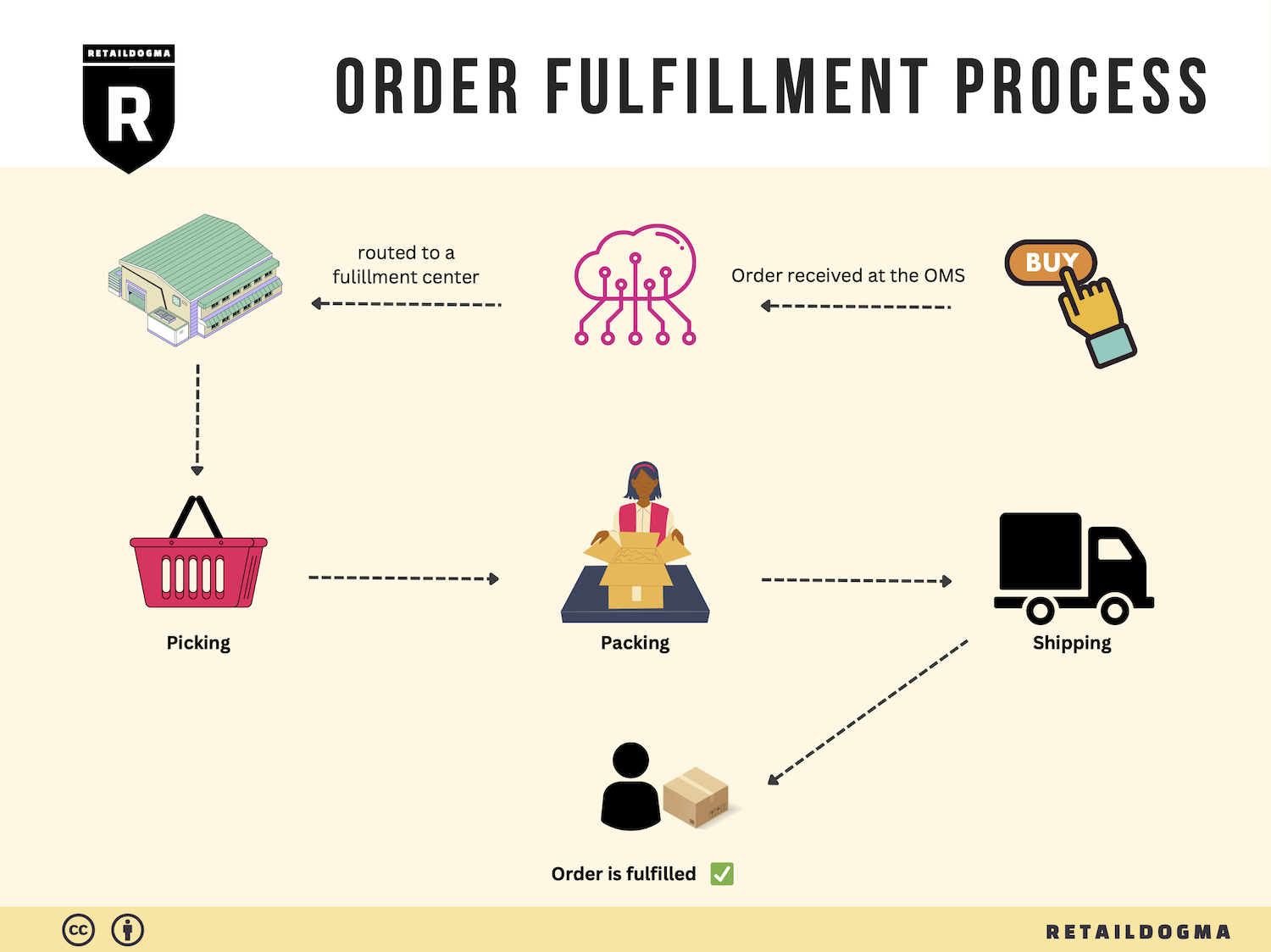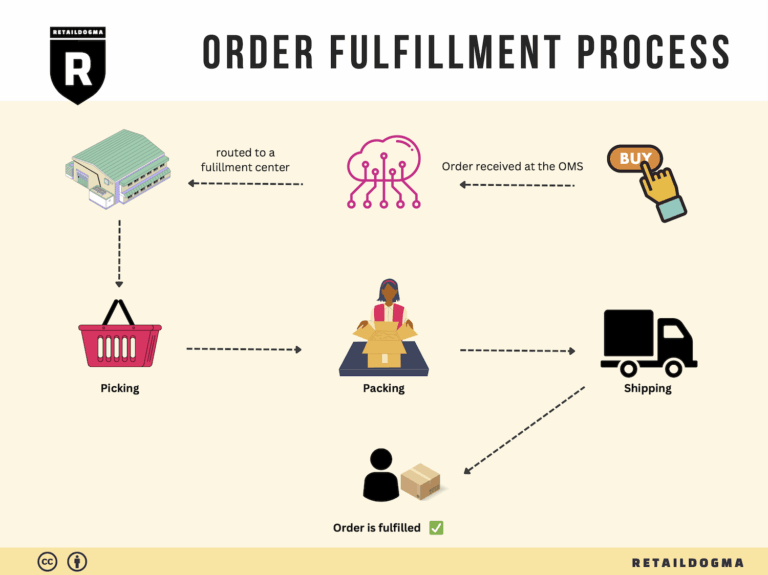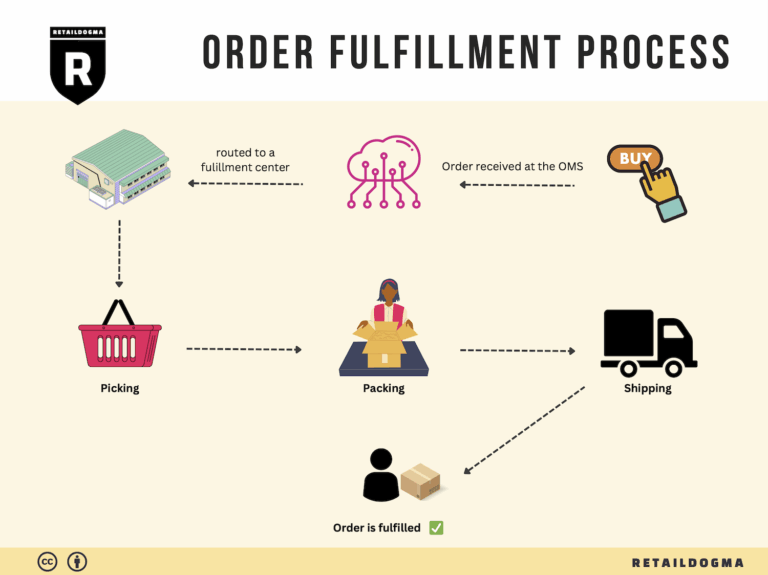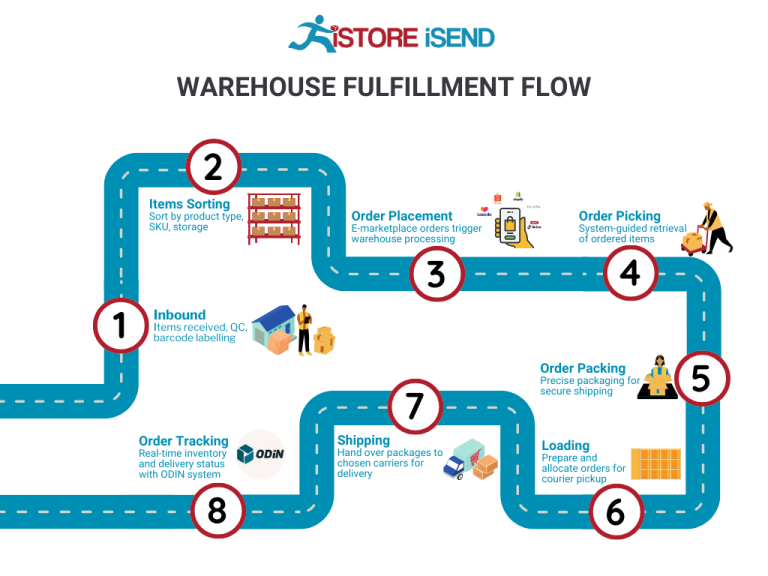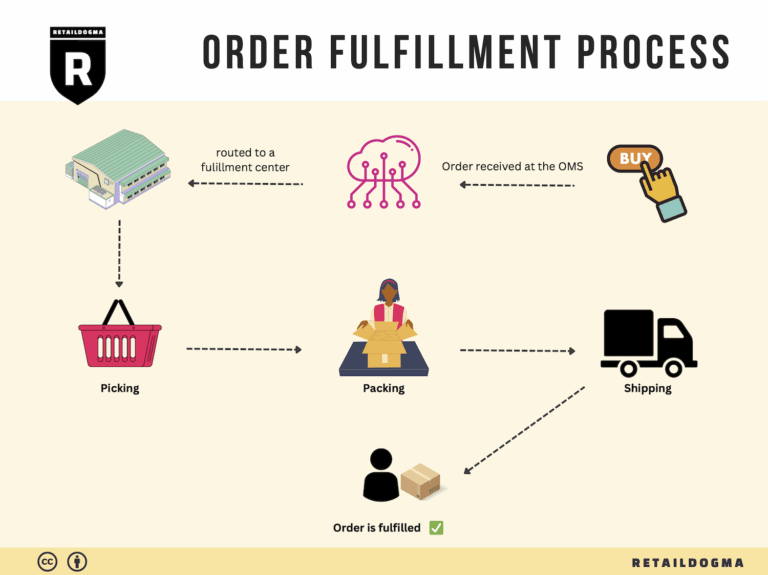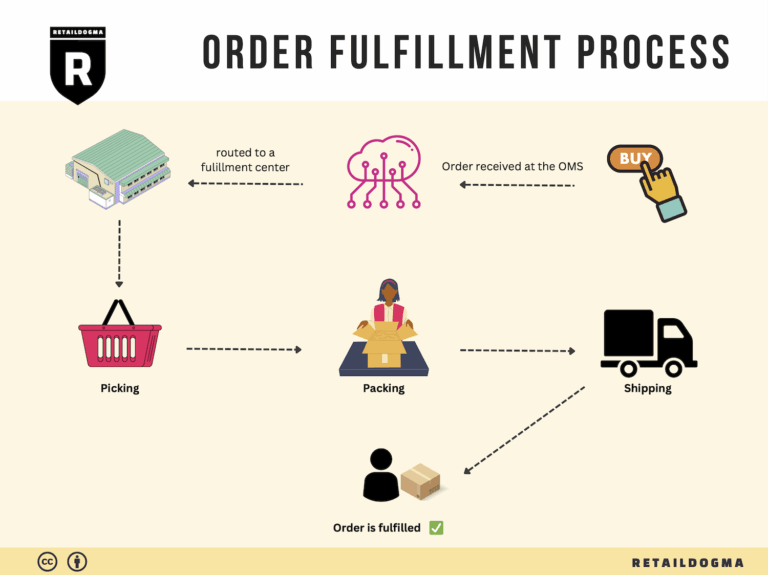What Is A Fulfillment Center? A Complete Guide (2025)
What is E-commerce Fulfillment? An Introduction for Growing Businesses
Understanding E-commerce Fulfillment
For many growing e-commerce businesses, the excitement of increasing sales can quickly turn into a daunting challenge when it comes to packing and shipping orders. Managing logistics can feel overwhelming, especially when you’re juggling customer expectations for fast delivery with the realities of inventory management and order processing. This is where e-commerce fulfillment steps in, serving as the backbone of your operations.
E-commerce fulfillment refers to the entire process of getting a product from your warehouse or supplier to the customer’s doorstep. It includes everything from receiving inventory and storing products to picking, packing, and shipping orders. As your business scales, understanding and optimizing this process becomes critical not only for maintaining customer satisfaction but also for sustaining growth.
This guide aims to demystify e-commerce fulfillment by exploring several key areas. First, we will discuss the different fulfillment models available to businesses today, such as Third-Party Logistics (3PL) and Fulfillment by Amazon (FBA). Each model has its own set of advantages and challenges, and understanding them can help you select the right option for your business needs.
Next, we’ll delve into the core services associated with fulfillment, including inventory management, order processing, and shipping options. Knowing what services are available allows you to tailor your fulfillment strategy to best fit your operational goals.
Choosing the right fulfillment partner is another crucial aspect we will cover. Your logistics partner can significantly impact your business’s efficiency and customer experience, so it’s essential to evaluate potential partners based on their capabilities, reliability, and alignment with your business values.
Finally, we will address pricing structures and what factors influence fulfillment costs. Understanding these can help you budget effectively and identify areas where you can optimize expenses without compromising service quality.
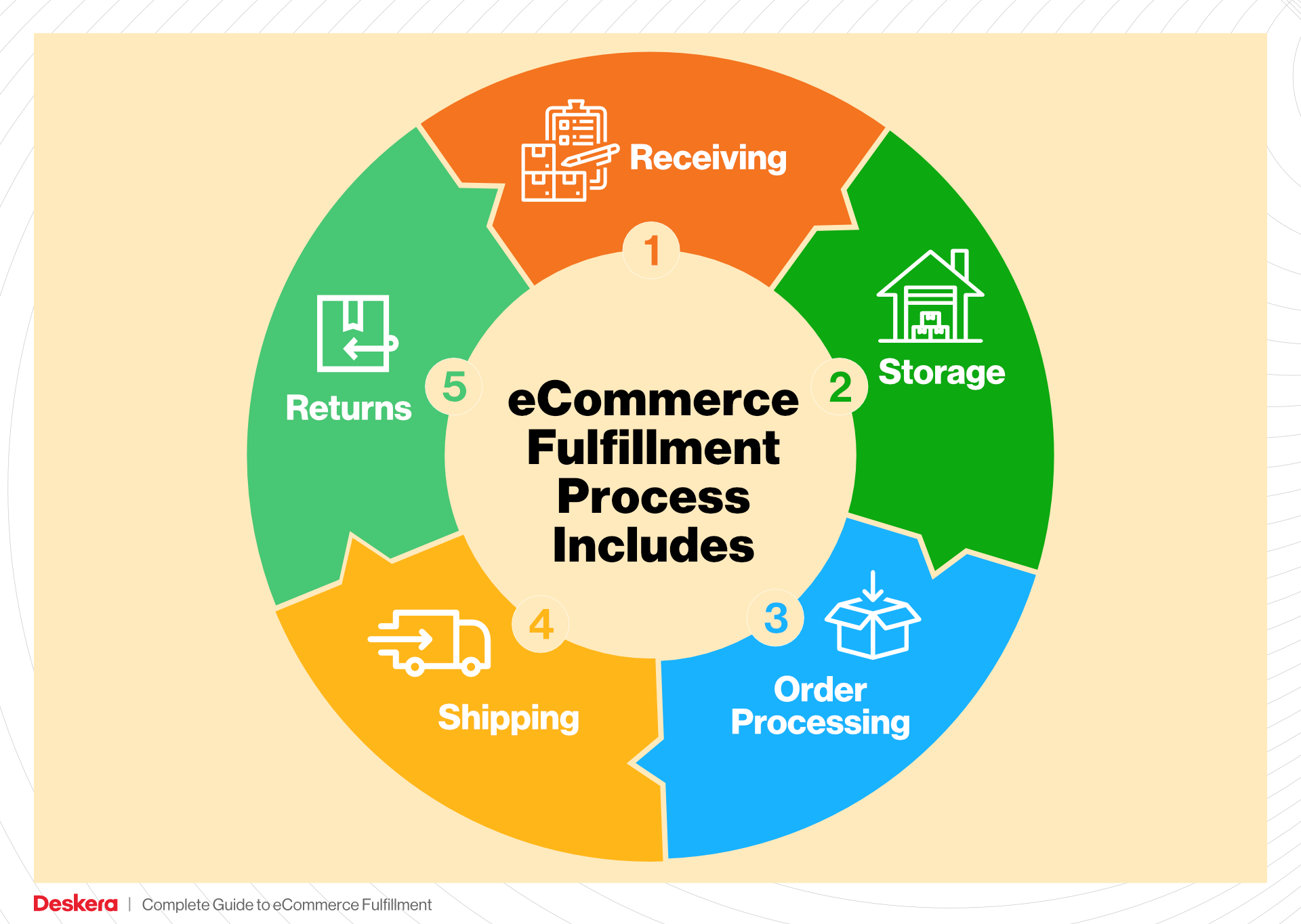
By the end of this guide, our goal is to empower you, the business owner, to make informed decisions about your logistics strategy. With the right knowledge and tools, you can streamline your fulfillment process, enhance customer satisfaction, and focus on what you do best—growing your business.
What You’ll Learn In This Guide
- What is E-commerce Fulfillment? An Introduction for Growing Businesses
- The Order Fulfillment Process: From ‘Buy’ Button to Customer’s Door
- Comparing Fulfillment Models: In-House vs. 3PL vs. Dropshipping
- A Deep Dive into Amazon FBA: Pros, Cons, and Who It’s For
- Core Services Offered by Fulfillment Centers
- How to Choose a Fulfillment Partner: A 6-Point Checklist
- Understanding Fulfillment Pricing: A Breakdown of Common Fees
- Frequently Asked Questions (FAQs) about Fulfillment
- Conclusion: Is Outsourcing Fulfillment the Right Move for Your Business?
- Important Disclaimer
The Order Fulfillment Process: From ‘Buy’ Button to Customer’s Door
1. Receiving Inventory
The order fulfillment process begins with receiving inventory. This step involves the acceptance of products from suppliers and manufacturers into your warehouse. Upon arrival, items are checked against the purchase order to ensure that the correct quantities and products have been delivered. This is crucial as discrepancies can lead to stockouts or overstock situations, which can hinder sales and customer satisfaction.
A key term associated with this step is SKU (Stock Keeping Unit). Each product should have a unique SKU for easy identification and tracking throughout the fulfillment process. Effective inventory receiving not only helps maintain accurate stock levels but also lays the groundwork for efficient warehouse management. Implementing a robust receiving protocol ensures that your inventory is accurate and ready for the next steps in the fulfillment chain.
2. Warehouse Storage
Once inventory is received, the next step is warehouse storage. This involves placing products in designated areas within the warehouse for easy access and organization. Effective warehouse storage is vital as it directly impacts the efficiency of the picking process. Products should be stored in a manner that optimizes space and minimizes retrieval time.
Utilizing systems such as ABC analysis can help prioritize storage based on product demand. High-demand items should be stored closer to the packing and shipping areas, while lower-demand items can be placed further away. Proper organization not only speeds up order fulfillment but also reduces the risk of errors when picking items for shipment.
3. Order Picking
The order picking stage is where the actual process of fulfilling customer orders begins. In this step, employees or automated systems retrieve the items from their storage locations based on incoming orders. This is a critical phase as the accuracy of picked items directly affects customer satisfaction.
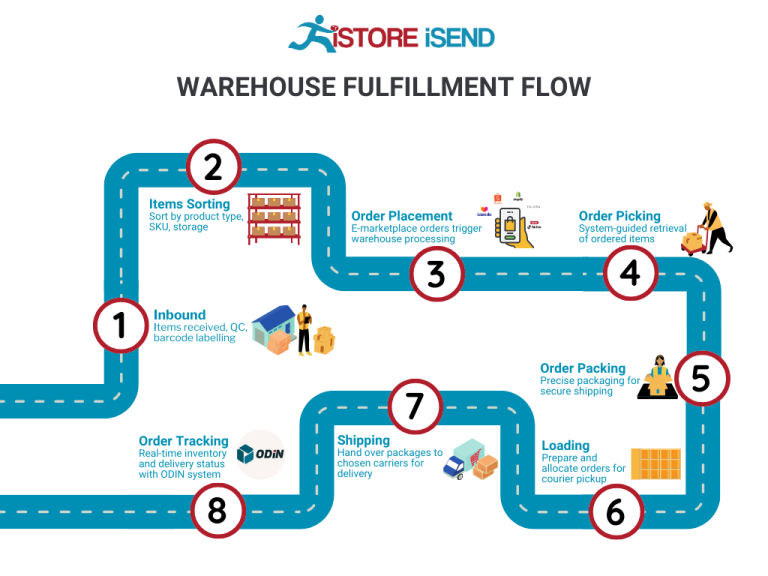
The use of pick lists is essential here. A pick list outlines the items and quantities needed for each order, guiding the picker through the warehouse. Efficient picking can be enhanced through various strategies, such as batch picking (where multiple orders are picked simultaneously) or zone picking (where pickers are assigned specific areas of the warehouse). Implementing efficient picking methods can significantly reduce labor costs and increase order throughput.
4. Order Packing
After the items are picked, they move to the order packing stage. This step involves securely packing the products for shipment, ensuring they arrive in good condition at the customer’s door. Proper packing techniques are essential to prevent damage during transit and can also enhance the unboxing experience for customers.
A key term in this process is packing slips. These documents are included with the order and detail the items contained within the package, serving as a receipt for the customer and a verification tool for the fulfillment team. Additionally, considering sustainable packing materials can resonate well with environmentally-conscious consumers, enhancing brand loyalty. Effective packing not only protects products but also reflects professionalism and care in customer service.
5. Shipping & Delivery
The final step in the order fulfillment process is shipping and delivery. Once packed, orders are labeled and handed over to shipping carriers for delivery to customers. Timely and accurate shipping is crucial for customer satisfaction and can influence repeat purchases.
During this stage, tracking information should be provided to customers, allowing them to monitor their shipment. The term last-mile delivery is particularly relevant here, referring to the final leg of the shipping journey to the customer’s address. Optimizing last-mile delivery can significantly enhance customer experience, as it often represents the final touchpoint between the business and the customer. By selecting reliable carriers and streamlining logistics, businesses can improve delivery speed and reliability, which are essential for maintaining a competitive edge in e-commerce.
In summary, the order fulfillment process consists of five interconnected steps: receiving inventory, warehouse storage, order picking, order packing, and shipping & delivery. Each step plays a vital role in ensuring that the customer receives their order accurately and promptly, ultimately contributing to the overall success of your e-commerce operations. By implementing best practices in each area, businesses can enhance efficiency, reduce costs, and improve customer satisfaction.
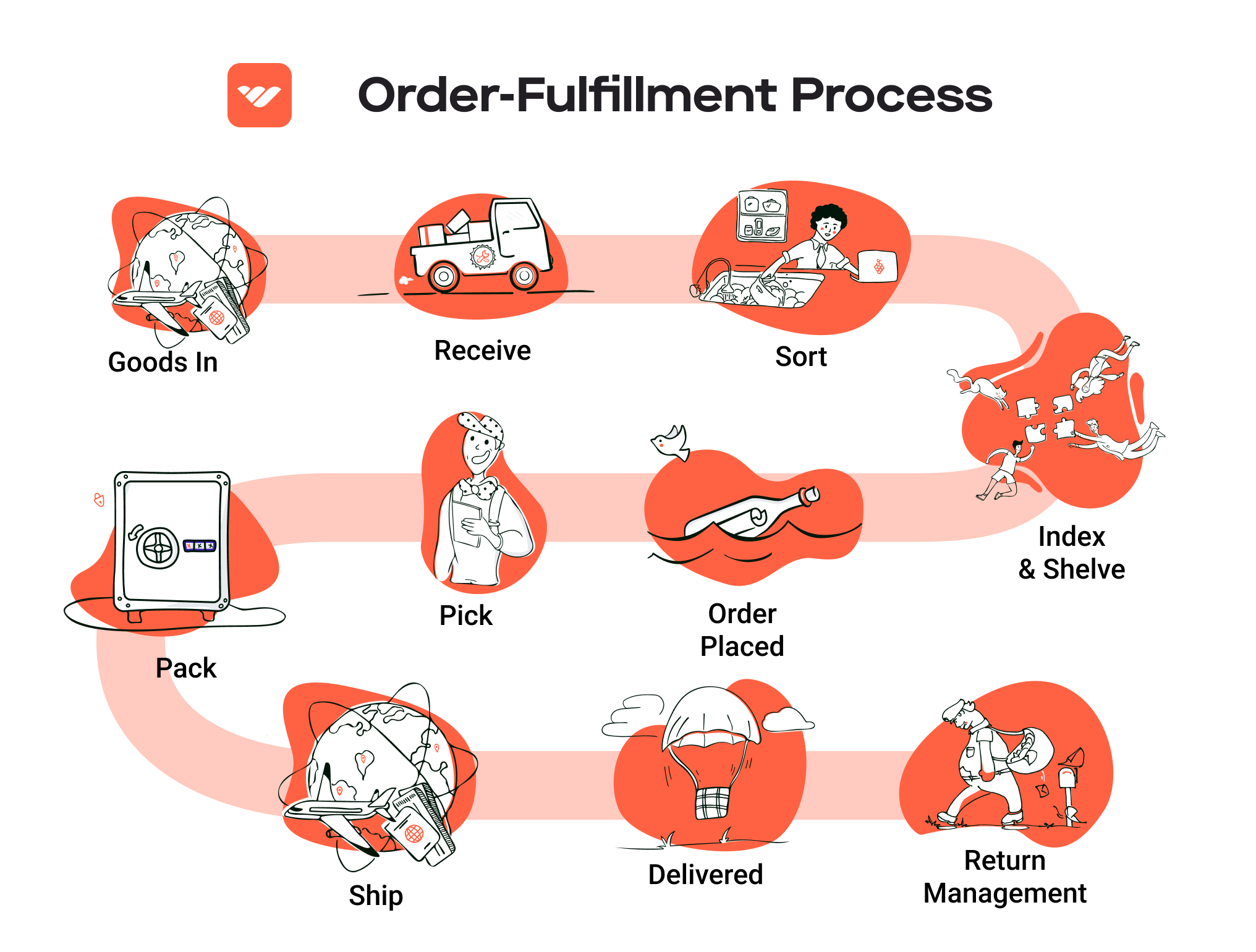
Comparing Fulfillment Models: In-House vs. 3PL vs. Dropshipping
Fulfillment Model Comparison
| Model | Who Handles Inventory | Best For (Business Stage) | Key Advantage | Key Disadvantage |
|---|---|---|---|---|
| In-House Fulfillment | Business itself | Startups to Established | Full control over operations and inventory | High overhead costs and resource requirements |
| Third-Party Logistics (3PL) | Third-party logistics provider | Growing to Established | Scalability and expertise in logistics | Less control over inventory and shipping times |
| Dropshipping | Supplier | Startups and Small Businesses | Low upfront investment and risk | Lower profit margins and reliance on suppliers |
In-House Fulfillment
In-house fulfillment involves managing all aspects of inventory, order processing, and shipping internally. This model is often favored by startups and established businesses that want complete control over their operations. By handling fulfillment in-house, companies can customize their processes, ensuring that they meet their specific needs and customer expectations. This model allows for better quality control, as businesses can oversee every step of the order fulfillment process, from picking and packing to shipping. However, the main drawbacks include high overhead costs associated with warehousing, staffing, and technology investments. As businesses scale, the complexity of managing logistics can increase, requiring more resources and potentially leading to inefficiencies if not managed properly.
Third-Party Logistics (3PL)
Third-party logistics (3PL) providers offer a comprehensive logistics solution, handling inventory management, warehousing, order processing, and shipping on behalf of the business. This model is ideal for growing companies that need to scale their operations without the burden of managing logistics themselves. By partnering with a 3PL provider, businesses can leverage the expertise and infrastructure of the logistics provider, allowing them to focus on their core competencies, such as marketing and product development. Additionally, 3PLs often have established networks that can lead to cost savings and improved shipping times. However, the downside is the loss of direct control over inventory and fulfillment processes, which can lead to discrepancies in service levels if the 3PL does not meet the business’s standards.
Dropshipping
Dropshipping is a fulfillment model where the retailer does not keep products in stock but instead transfers customer orders to a supplier, who then ships the products directly to the customer. This model is particularly appealing for startups and small businesses, as it requires minimal upfront investment in inventory and reduces the risk associated with unsold stock. With dropshipping, entrepreneurs can test new products and markets without the financial commitment of traditional inventory management. However, dropshipping comes with its challenges, including lower profit margins due to reliance on suppliers, potential delays in shipping times, and limited control over product quality. Businesses must also navigate the complexities of supplier relationships to ensure a consistent customer experience.
Conclusion
Choosing the right fulfillment model is a critical decision for e-commerce businesses aiming to scale effectively. Each model has its unique advantages and disadvantages, and the best choice often depends on the business’s stage of growth, resources, and strategic goals. In-house fulfillment provides control but requires significant investment, while 3PL offers scalability and expertise but at the cost of some oversight. Dropshipping minimizes risk and investment but can lead to lower margins and potential quality issues. Business owners should carefully evaluate their needs and consider how each model aligns with their long-term vision to ensure sustainable growth and customer satisfaction.
A Deep Dive into Amazon FBA: Pros, Cons, and Who It’s For
Understanding Fulfillment by Amazon (FBA)
Fulfillment by Amazon (FBA) is a service offered by Amazon that allows e-commerce sellers to store their products in Amazon’s fulfillment centers. Amazon then takes care of storage, packaging, and shipping to customers. This service not only simplifies logistics for sellers but also provides them access to Amazon’s vast customer base and resources.
When a customer orders a product, Amazon handles the entire process—from picking the item from the warehouse to packing it, shipping it, and even managing customer service and returns. Sellers simply need to focus on sourcing their products and marketing them effectively.
How FBA Works
-
Set Up Your Account: Sellers first need to create an Amazon Seller account and enroll in the FBA program.
-
List Your Products: Once enrolled, sellers can list their products on Amazon. They can either create new listings or convert existing listings to FBA.
-
Prepare and Ship Inventory: Sellers prepare their products according to Amazon’s guidelines and ship them to designated fulfillment centers. Amazon provides sellers with shipping labels and guidelines on how to package their products.
-
Storage and Fulfillment: Amazon stores the inventory in their warehouses. When a customer places an order, Amazon picks, packs, and ships the product directly to the customer.
-
Customer Service and Returns: Amazon also handles customer service inquiries and returns for FBA products, allowing sellers to focus on growing their business rather than customer interactions.
Pros of Fulfillment by Amazon (FBA)
1. Prime Eligibility
One of the most significant advantages of using FBA is that products become eligible for Amazon Prime. This means that Prime members can receive their orders with free two-day shipping, which significantly increases the likelihood of sales. Prime members tend to spend more on Amazon, making this a valuable asset for sellers.
2. Customer Trust
Amazon is a globally recognized brand, and customers trust the platform. By using FBA, sellers can leverage this trust. Products fulfilled by Amazon are often perceived as more reliable, leading to higher conversion rates. Additionally, the customer service provided by Amazon adds to this trust, as customers know they can rely on Amazon for support.
3. Multi-Channel Fulfillment
FBA offers multi-channel fulfillment options, allowing sellers to use Amazon’s logistics services for orders placed on other platforms, such as their own website or eBay. This flexibility allows businesses to streamline their logistics while still reaching customers on multiple channels.
4. Simplified Logistics
With Amazon handling storage, packing, shipping, and returns, sellers can focus more on their core business activities, such as product development and marketing. This can be particularly beneficial for small to medium-sized businesses that may not have the resources to manage their own fulfillment operations.
5. Access to Advanced Tools
FBA provides sellers with access to advanced tools and analytics, including inventory management, sales reports, and advertising options. This data-driven approach can help sellers make informed decisions to optimize their inventory and marketing strategies.
Cons of Fulfillment by Amazon (FBA)
1. High Fees
One of the most significant drawbacks of FBA is the cost. Amazon charges various fees, including storage fees for inventory stored in their warehouses and fulfillment fees for each unit sold. These costs can add up quickly, especially for sellers with low margins or slow-moving inventory.
2. Strict Inventory Rules
Amazon has strict guidelines regarding inventory management, including requirements for labeling, packaging, and shipping. Sellers must adhere to these rules to avoid penalties, which can be cumbersome and time-consuming. Additionally, failure to comply may result in additional fees or even suspension from the FBA program.
3. Commingling Risks
FBA uses a process called commingling, where inventory from different sellers is stored in the same location. While this can streamline operations, it poses risks. If a customer receives a defective product or one that does not match the seller’s quality standards, it could lead to negative reviews for the seller, even if the issue originated from another seller’s inventory.
4. Loss of Control
By using FBA, sellers relinquish control over the fulfillment process. This can lead to concerns about product handling, packaging quality, and shipping times. If issues arise, sellers may find it challenging to resolve them quickly, which can impact customer satisfaction.
5. Inventory Management Challenges
While Amazon provides tools for managing inventory, sellers still need to monitor their stock levels closely. Overestimating demand can lead to high storage fees, while underestimating can result in stockouts and lost sales.
Who is FBA Best For?
Fulfillment by Amazon is particularly beneficial for e-commerce businesses that:
- Have High Sales Volume: Businesses with a high sales volume can better absorb FBA fees and benefit significantly from Amazon’s logistics capabilities.
- Sell Prime-Eligible Products: If your products cater to customers looking for fast shipping, FBA can provide a competitive edge through Prime eligibility.
- Lack Fulfillment Resources: Small to medium-sized businesses without the infrastructure to handle their own logistics will find FBA an excellent way to streamline operations.
- Are Looking to Scale: Businesses aiming to scale quickly can leverage FBA to manage logistics without the overhead costs of establishing their own fulfillment centers.
- Sell on Multiple Platforms: Those who sell on Amazon and other platforms can use FBA for a consistent fulfillment experience across channels.
In conclusion, while FBA offers numerous advantages, it also presents challenges that sellers must navigate. Understanding these pros and cons can help e-commerce business owners make informed decisions about whether FBA is the right fit for their fulfillment strategy.
Core Services Offered by Fulfillment Centers
Inventory Management & Warehousing
Effective inventory management is the cornerstone of any successful e-commerce operation. Fulfillment centers offer sophisticated inventory management systems that enable businesses to track stock levels in real-time, forecast demand, and maintain optimal inventory levels. This service typically includes receiving, storing, and organizing products in a warehouse environment designed for efficiency.
The benefits of robust inventory management are manifold. For one, it helps prevent stockouts and overstock situations, which can lead to lost sales or increased holding costs. By utilizing advanced inventory software, fulfillment centers can automate reorder points, ensuring that stock is replenished before it runs out. This not only streamlines operations but also enhances customer satisfaction, as orders can be fulfilled quickly and accurately. Furthermore, accurate inventory management allows businesses to make informed decisions regarding product offerings, enabling them to adapt to market trends and consumer preferences effectively.
Pick and Pack Services
Pick and pack services refer to the process of selecting items from inventory (picking) and preparing them for shipment (packing). Fulfillment centers employ trained staff and automated systems to efficiently handle this crucial aspect of order fulfillment. Orders are picked based on specific customer requests and then packed securely to ensure safe delivery.
The primary advantage of pick and pack services is the increased speed and accuracy of order fulfillment. With a dedicated team managing this process, e-commerce businesses can significantly reduce the time it takes to get products into the hands of customers. Additionally, fulfillment centers often use advanced picking technologies, such as barcode scanners and mobile devices, to minimize errors and enhance operational efficiency. This not only improves customer satisfaction through timely deliveries but also optimizes labor costs, allowing businesses to scale operations without the need for a large in-house workforce.
Kitting and Assembly
Kitting and assembly involve bundling individual items into a single product or preparing products for sale in a specific configuration. This service is particularly beneficial for businesses that offer subscription boxes, promotional packages, or products that require assembly before shipping. Fulfillment centers can handle the entire process, from assembling the components to packaging the final product for shipment.
The key benefit of kitting and assembly services lies in their ability to enhance product presentation and increase perceived value. By offering bundled products, businesses can create a more compelling value proposition for customers, often leading to higher sales and customer loyalty. Moreover, outsourcing kitting and assembly to a fulfillment center allows e-commerce businesses to focus on core activities such as marketing and customer service, rather than being bogged down by labor-intensive assembly tasks. This flexibility can be crucial for scaling operations, especially during peak seasons or promotional events.
Returns Management (Reverse Logistics)
Returns management, or reverse logistics, is the process of handling products that customers return after purchase. Fulfillment centers streamline this process by providing a structured approach to receiving, inspecting, and restocking returned items. They also manage the necessary paperwork and customer communications associated with returns.
The importance of efficient returns management cannot be overstated. In e-commerce, the return rate can be significantly higher than in traditional retail, making a well-organized returns process essential for customer satisfaction. A fulfillment center can help businesses minimize losses associated with returns by quickly assessing the condition of returned items and determining the best course of action—whether to restock, refurbish, or recycle the products. Additionally, a seamless returns process enhances customer trust and loyalty, as customers appreciate businesses that make returns easy and hassle-free. This can lead to repeat purchases, which are vital for long-term growth.
In conclusion, leveraging the core services offered by fulfillment centers—inventory management, pick and pack services, kitting and assembly, and returns management—can significantly enhance the operational efficiency of e-commerce businesses. By outsourcing these functions, entrepreneurs can focus on strategic growth initiatives while ensuring that their logistics are handled professionally and effectively.
How to Choose a Fulfillment Partner: A 6-Point Checklist
Location & Warehouse Network
Importance: The geographical location of your fulfillment partner’s warehouses can significantly impact shipping costs and delivery times. A partner with strategically placed facilities can help you reach your customers more efficiently.
Questions to Ask:
– Where are your warehouses located, and how many do you operate?
– How does your location affect shipping times to my primary customer base?
– Do you have plans to expand your warehouse network in the future?
– Can you provide regional distribution options to optimize shipping costs?
Technology & Integrations
Importance: In the digital age, seamless integration with your existing systems (like e-commerce platforms, inventory management, and order processing software) is crucial for maintaining operational efficiency. The right technology stack can enhance visibility into inventory levels and order statuses.
Questions to Ask:
– What technology platforms do you use for order management and inventory tracking?
– Can your systems integrate with my current e-commerce platform (e.g., Shopify, WooCommerce)?
– How do you handle data security and privacy?
– Do you offer real-time tracking for shipments, and how can I access this information?
Specializations (e.g., Cold Storage, Oversized Items)
Importance: Depending on your product types, you may require specific capabilities. For instance, if you sell perishable goods, a partner with cold storage capabilities is essential. Similarly, oversized items may require specialized handling and shipping solutions.
Questions to Ask:
– What types of products are you specialized in fulfilling?
– Do you have the facilities and equipment to handle specialized storage needs (e.g., cold storage, hazardous materials)?
– How do you manage inventory for specialized items?
– Can you accommodate seasonal fluctuations in demand for specialized products?
Scalability & Capacity
Importance: As your business grows, your fulfillment needs will change. A partner that can scale with you will help ensure that you can meet increasing demand without compromising service quality.
Questions to Ask:
– How do you handle peak seasons and unexpected surges in order volume?
– What is your capacity for scaling operations up or down?
– Can you provide historical data on how you’ve managed scalability for other clients?
– What processes do you have in place to ensure that quality is maintained during periods of growth?
Pricing and Contracts
Importance: Understanding the pricing structure and contract terms is vital to ensure your fulfillment costs align with your budget. Hidden fees can quickly erode your margins, so clarity is essential.
Questions to Ask:
– What is your pricing model (e.g., per order, per item, monthly fees)?
– Are there additional costs for services such as storage, packaging, or returns?
– Can you provide a detailed breakdown of all potential fees?
– What are the contract terms, and is there flexibility for renegotiation as my needs change?
Customer Support & Reviews
Importance: Reliable customer support can make or break your relationship with a fulfillment partner. A responsive support team can resolve issues quickly, ensuring minimal disruption to your operations.
Questions to Ask:
– What customer support options do you offer (e.g., phone, email, live chat)?
– What are your average response times for customer inquiries?
– Can you provide references or case studies from current or past clients?
– How do you handle issues such as lost or damaged shipments, and what is your process for resolving disputes?
Conclusion
Choosing the right fulfillment partner is a critical decision that can influence your e-commerce business’s operational efficiency and customer satisfaction. By following this checklist and asking the right questions, you can ensure you select a partner that aligns with your business needs and supports your growth objectives. Prioritize what matters most for your specific operations, and don’t hesitate to seek out multiple partners for comparison before making your final choice.
Understanding Fulfillment Pricing: A Breakdown of Common Fees
Initial Setup Fees
Initial setup fees are typically charged by fulfillment centers to cover the costs associated with onboarding a new client. These fees can vary widely based on the complexity of your business and the services required. Common components of initial setup fees include:
- Account Setup: This often includes creating your account in the fulfillment center’s system and integrating it with your e-commerce platform.
- Inventory Integration: If you have existing inventory, the fulfillment center may charge for the time taken to enter your products into their system, including product descriptions, SKUs, and pricing.
- Custom Packaging Setup: If you require specific packaging materials or branding, there may be additional charges to procure or set up these items.
These fees are usually a one-time cost but can range from a few hundred to several thousand dollars, depending on the scale and needs of your operation.
Receiving Fees
Receiving fees are charged when your inventory arrives at the fulfillment center. This fee is calculated based on the volume of products received, which can be measured in units or pallets. Factors that influence receiving fees include:
- Quantity of Items: Larger shipments or more items often lead to higher receiving fees.
- Complexity of Receiving: If your products require special handling or inspection, additional charges may apply.
- Labor Costs: The time taken by staff to unload, inspect, and store your products can also contribute to the receiving fee.
Expect receiving fees to be priced per pallet or per item, and always confirm the specific metrics used by your fulfillment partner.
Storage Fees (per pallet/bin)
Storage fees are recurring charges based on the amount of space your inventory occupies within the fulfillment center. These fees are typically calculated on a monthly basis and can be charged per pallet, bin, or cubic foot. Key considerations include:
- Volume of Inventory: More inventory translates to higher storage fees, as you will be occupying more space.
- Duration of Storage: Some fulfillment centers implement tiered pricing based on how long your products are stored. Long-term storage can incur additional fees.
- Seasonal Variability: Storage costs may fluctuate seasonally, especially during peak shopping periods, so it’s crucial to plan accordingly.
Understanding the storage fee structure is essential for budgeting and managing your inventory levels effectively.
Pick & Pack Fees (per item/order)
Pick & pack fees are charged for the labor involved in picking items from inventory and packing them for shipment. These fees can be calculated per item or per order. Factors influencing these fees include:
- Number of Items: More items per order typically lead to higher pick & pack fees, as it requires more time and labor.
- Complexity of Packing: If your products require special packing methods, such as fragile items needing additional cushioning, this may increase fees.
- Automation: Some fulfillment centers utilize automated systems that can reduce labor costs, potentially lowering pick & pack fees.
Businesses should assess their average order size and complexity to estimate these fees accurately.
Shipping Fees
Shipping fees encompass the costs associated with delivering your products to customers. These can vary significantly based on multiple factors:
- Shipping Carrier: Different carriers (e.g., USPS, FedEx, UPS) have varying rates, and some fulfillment centers may offer negotiated rates based on their volume.
- Shipping Speed: Expedited shipping options will incur higher fees compared to standard delivery.
- Destination: Shipping costs vary based on the distance from the fulfillment center to the customer’s location.
It’s important to understand how shipping fees are structured, as they can significantly impact your overall fulfillment costs.
Tips for Getting an Accurate Quote
-
Provide Comprehensive Information: When seeking quotes, provide detailed information about your inventory, including the types of products, expected order volumes, and any special handling requirements.
-
Ask for a Breakdown: Request a detailed breakdown of all fees, including initial setup, receiving, storage, pick & pack, and shipping. This transparency will help you compare options effectively.
-
Consider Seasonal Variability: Discuss how seasonal changes might affect your fees, particularly for storage and shipping, to avoid unexpected costs.
-
Negotiate Terms: Don’t hesitate to negotiate terms with fulfillment centers, especially if you expect high volumes. Many providers are willing to adjust fees based on projected business.
-
Evaluate Long-Term Costs: Look beyond initial quotes and consider the long-term costs associated with each fulfillment partner, including any hidden fees that may arise.
By understanding these common fulfillment pricing models and utilizing these tips, e-commerce business owners can make informed decisions, optimize their logistics operations, and ultimately scale their businesses more efficiently.
Frequently Asked Questions (FAQs) about Fulfillment
1. What is fulfillment in e-commerce?
Fulfillment in e-commerce refers to the entire process of receiving, processing, and delivering customer orders. It involves inventory management, order picking, packing, shipping, and often returns management. Effective fulfillment ensures that customers receive their products promptly and in good condition, which is vital for customer satisfaction and retention.
2. What is the difference between a warehouse and a fulfillment center?
A warehouse is primarily a storage facility for inventory, while a fulfillment center is a specialized warehouse designed to manage the entire order fulfillment process. Fulfillment centers focus on quick order processing, picking, packing, and shipping directly to customers, often integrating technology to optimize these operations.
3. What is a 3PL (Third-Party Logistics)?
A 3PL provider is a company that offers outsourced logistics services, including warehousing, fulfillment, and transportation. By partnering with a 3PL, businesses can leverage the provider’s expertise, technology, and infrastructure to streamline their logistics operations, reduce costs, and improve service levels without managing these processes in-house.
4. How much do fulfillment services cost?
The cost of fulfillment services can vary widely based on factors such as order volume, storage needs, shipping methods, and additional services like returns processing or custom packaging. Typically, fulfillment providers charge a per-order fee, a monthly storage fee for inventory, and shipping costs based on package weight and destination. It’s crucial to compare quotes from various providers to find the best fit for your business.
5. How does HCP fulfillment in Fort Lauderdale differ from other providers?
HCP fulfillment in Fort Lauderdale emphasizes personalized service, particularly in compounding and specialty medications. Their approach includes close communication with healthcare providers and tailored solutions to meet unique patient needs, ensuring that medications are delivered accurately and promptly.
6. What types of products can be fulfilled by HCP in Fort Lauderdale?
HCP specializes in fulfilling custom compounded medications, durable medical equipment, and retail pharmacy products. This includes specialized pharmaceutical formulations that are not available commercially, catering specifically to the needs of patients and healthcare providers.
7. What technology is used in fulfillment processes?
Modern fulfillment centers utilize various technologies to streamline operations, including inventory management systems, order management software, barcode scanning for picking accuracy, and automated shipping solutions. These technologies enhance efficiency, reduce errors, and provide real-time tracking for both businesses and customers.
8. How can I scale my fulfillment operations as my business grows?
To scale fulfillment operations, consider partnering with a reliable 3PL that can accommodate increased order volumes. Invest in scalable technology solutions that can adapt to growing inventory and order management needs. Additionally, regularly review and optimize your fulfillment processes for efficiency, including assessing shipping methods and packaging options.
9. What are the benefits of using a local fulfillment provider like HCP in Fort Lauderdale?
Using a local fulfillment provider offers several benefits, including faster shipping times to local customers, reduced shipping costs, and enhanced communication due to proximity. Local providers like HCP also understand regional regulations and customer preferences, which can be advantageous for compliance and service quality.
10. How do I choose the right fulfillment partner for my business?
When selecting a fulfillment partner, consider factors such as their experience in your industry, technology capabilities, pricing structure, and the range of services offered. It’s also essential to evaluate their customer service and communication practices, as a responsive partner will better support your business needs and enhance customer satisfaction.
Conclusion: Is Outsourcing Fulfillment the Right Move for Your Business?
Evaluating the Benefits of Outsourcing Fulfillment
Outsourcing your fulfillment process can be a game-changer for e-commerce businesses looking to scale efficiently. One of the primary advantages is the significant time savings. By leveraging a fulfillment service, you can redirect valuable resources away from logistics and inventory management, allowing you to focus on core business functions like marketing, sales, and customer engagement. This shift not only enhances productivity but also fosters innovation and growth.
Scalability is another crucial benefit. As your business grows, so does the complexity of your fulfillment needs. A dedicated fulfillment partner can adapt to fluctuating demands, handling increased order volumes seamlessly without compromising service quality. This flexibility is vital for businesses that experience seasonal spikes or are entering new markets, ensuring you can meet customer expectations consistently.
Moreover, partnering with an experienced fulfillment provider brings specialized expertise to the table. These providers understand the intricacies of logistics, from inventory management to shipping regulations, which can significantly reduce errors and improve delivery times. Their established networks can also offer cost-effective shipping solutions that may not be available to individual businesses, further enhancing your bottom line.
However, choosing the right fulfillment partner is critical. A misaligned partnership can hinder growth rather than support it. Take the time to evaluate potential partners based on their capabilities, technology, and alignment with your business goals.
Next Steps: Audit Your Shipping Process
As you contemplate the decision to outsource fulfillment, consider conducting a thorough audit of your current shipping and logistics processes. Identify inefficiencies, pain points, and areas for improvement. This analysis will help determine if partnering with a fulfillment service is the right strategic move for your business, positioning you for sustainable growth and operational excellence.
Important Disclaimer
⚠️ Important Disclaimer
The information in this guide is for educational purposes. Fulfillment services, pricing, and platform features change frequently. Always conduct your own due diligence and consult with providers directly before making business decisions.
